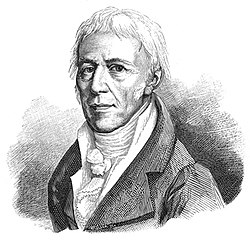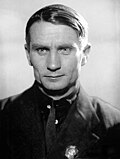Lamarckism
Lamarckism (also called Lamarckian evolution) is a wrong hypothesis regarding evolution. Evolution tries to explain how species change over time. Today, the only widely accepted theory of evolution is that developed from the ideas of Charles Darwin.
Lamarckism is named after Jean-Baptiste de Lamarck. He based his ideas, to some extent, on those of Erasmus Darwin, the grandfather of Charles Darwin. Lamarckism says that individuals do not only pass on the things they received from their parents, but also some things they experienced during their lifetime. As an example, he cited giraffes. Giraffes, which have long necks, must have evolved from ancestors with much shorter necks. His idea was that adults needed to stretch their neck to reach leaves from high branches. Therefore, he thought, the children inherited longer necks. This idea is called the inheritance of acquired characteristics.
Although Darwin did not entirely break with these ideas, his characteristic idea of natural selection relates to the individuals's relative survival and success in reproduction. Better adapted forms leave, on average, more offspring. This changes the proportion of alleles in the population.
Gregor Mendel discovered some basic rules of heredity. These rules of Mendelian inheritance contradict Lamarck's hypotheses entirely, but are consistent with natural selection. This explains why Lamarck's ideas are no longer regarded as a sound explanation of evolution. Where Lamarck and Darwin do agree is that evolution did take place.
Lamarck's theory
The identification of "Lamarckism" with the inheritance of acquired characteristics alone is regarded by some as an over-simplification, rehashed in textbooks repeatedly. Stephen Jay Gould wrote that late 19th century evolutionists "re-read Lamarck, cast aside the guts of it... and elevated one aspect of the mechanics – inheritance of acquired characters – to a central focus it never had for Lamarck himself".[1] He argued that "the restriction of Lamarckism to this relatively small and non-distinctive corner of Lamarck's thought must be labelled as more than a misnomer, and truly a discredit to the memory of a man and his much more comprehensive system".[2] Gould advocated defining "Lamarckism" more broadly, in line with Lamarck's overall evolutionary theory.
However, as scientist historians such as Michael Ghiselin and Stephen Jay Gould have pointed out, none of these views were original to Lamarck.[3][4] On the contrary, Lamarck's contribution was a systematic theoretical framework for understanding evolution. He saw evolution as comprising two processes;
- Le pouvoir de la vie (a complexifying force) – in which the natural, alchemical movements of fluids would etch out organs from tissues, leading to ever more complex construction regardless of the organ's use or disuse. This would drive organisms from simple to complex forms.
- L'influence des circonstances (an adaptive force) – in which the use and disuse of characters led organisms to become more adapted to their environment. This would take organisms sideways off the path from simple to complex, specialising them for their environment.
In essence, a change in the environment brings about a change in needs (besoins), resulting in a change in behavior, bringing change in organ usage and development, bringing change in form over time — and thus the gradual transmutation (change) of the species.
The modern point of view is that neither of his two 'forces' exists; Lamarck can be credited with the first fully worked-out account of evolution. However, his ideas of how it came about are entirely mistaken.[5]
Lamarckism Media
Lamarck argued, as part of his theory of heredity, that a blacksmith's sons inherit the strong muscles the blacksmith acquires from his work.
Jean-Baptiste Lamarck repeated the ancient folk wisdom of the inheritance of acquired characteristics.
Charles Darwin's pangenesis theory. Every part of the body emits tiny gemmules which migrate to the gonads and contribute to the next generation via the fertilised egg. Changes to the body during an organism's life would be inherited, as in Lamarckism.
August Weismann's germ plasm theory. The hereditary material, the germ plasm, is confined to the gonads and the gametes. Somatic cells (of the body) develop afresh in each generation from the germ plasm, creating an invisible "Weismann barrier" to Lamarckian influence from the soma to the next generation.
The long neck of the giraffe is often used as an example in popular explanations of Lamarckism. However, this was only a small part of his theory of evolution towards "perfection"; it was a hypothetical illustration; and he used it to discuss his theory of heredity, not evolution.
Charles-Édouard Brown-Séquard tried to demonstrate Lamarckism by mutilating guinea pigs.
Paul Kammerer claimed in the 1920s to have found evidence for Lamarckian inheritance in midwife toads, in a case celebrated by the journalist Arthur Koestler, but the results are thought to be either fraudulent or at best misinterpreted.
Trofim Lysenko promoted an ideological form of neo-Lamarckism which adversely influenced Soviet agricultural policy in the 1930s.
References
- ↑ Gould, Stephen J. "Shades of Lamarck", reprinted in The Panda's Thumb (1980) pp.65-71. Quote from page 66.
- ↑ Gould, Stephen J. (2002). The structure of evolutionary theory. Harvard: Belknap Harvard. pp. 177–178. ISBN 0-674-00613-5.
- ↑ The Imaginary Lamarck: a look at bogus "history" in schoolbooks Archived 2000-10-12 at the Wayback Machine by Michael Ghiseli]
- ↑ Gould, S.J. (2002) The structure of evolutionary theory
- ↑ Mayr, Ernst. 2001. What evolution is. Harvard.










